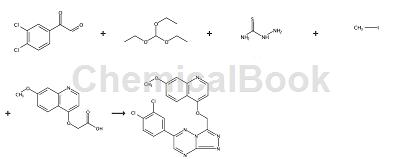Overview[1]
3,4-Dichlorophenylglyoxal hydrate is the monohydrate of 3,4-dichlorophenylglyoxal. 3,4-Dichlorophenylglyoxal is an organic intermediate and has been reported to be used in the preparation of c-Met inhibitors.
Apply[1]
CN201010579221.0 reports [1,2,4]triazolo[4,3‑b][1,2,4]triazine compounds, pharmaceutically acceptable salts thereof, prodrugs thereof and hydrates thereof or Solvates, also relate to methods for the preparation of said compounds, pharmaceutical compositions containing said compounds and their use as protein tyrosine kinase inhibitors, especially as c-Met inhibitors, in the preparation of prevention and/or treatment of c- Use in drugs for diseases related to Met abnormalities. 3,4-Dichlorophenylglyoxal can be used to prepare such compounds, as shown below.

Receptor-type protein tyrosine kinase c‑Met is the hepatocyte growth factor receptor (HGFR), encoded by the MET proto-oncogene. Mature Met consists of an extracellular α chain (50KDa) and a transmembrane β chain (145KDa, which anchors the intracellular segment containing the kinase region to the cell membrane) to function as a heterodimer. c‑Met is highly expressed in most cancers and some sarcomas and is closely related to poor prognosis, such as lung cancer, breast cancer, colon cancer, prostate cancer, pancreatic cancer, gastric cancer, liver cancer, ovarian cancer, kidney cancer, and neuroblastoma. tumors, melanoma, etc. c‑Met interacts with its ligand HGF/SF or activates intracellular tyrosine kinase through other pathways, inducing cell proliferation, invasion, migration, inhibiting apoptosis, and promoting angiogenesis. It plays a key role in the occurrence and development of tumors. play an important role.
Main reference materials
[1] [Chinese invention] CN201010579221.0 [1,2,4]triazolo[4,3-b][1,2,4]triazine compounds, their preparation methods and uses

 微信扫一扫打赏
微信扫一扫打赏

